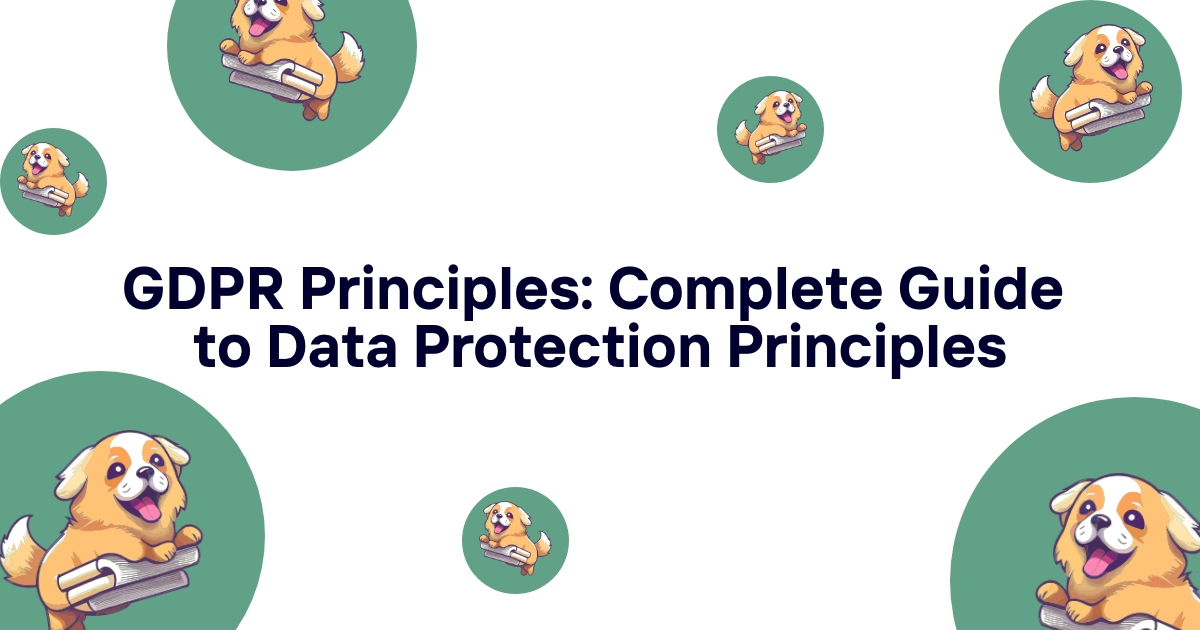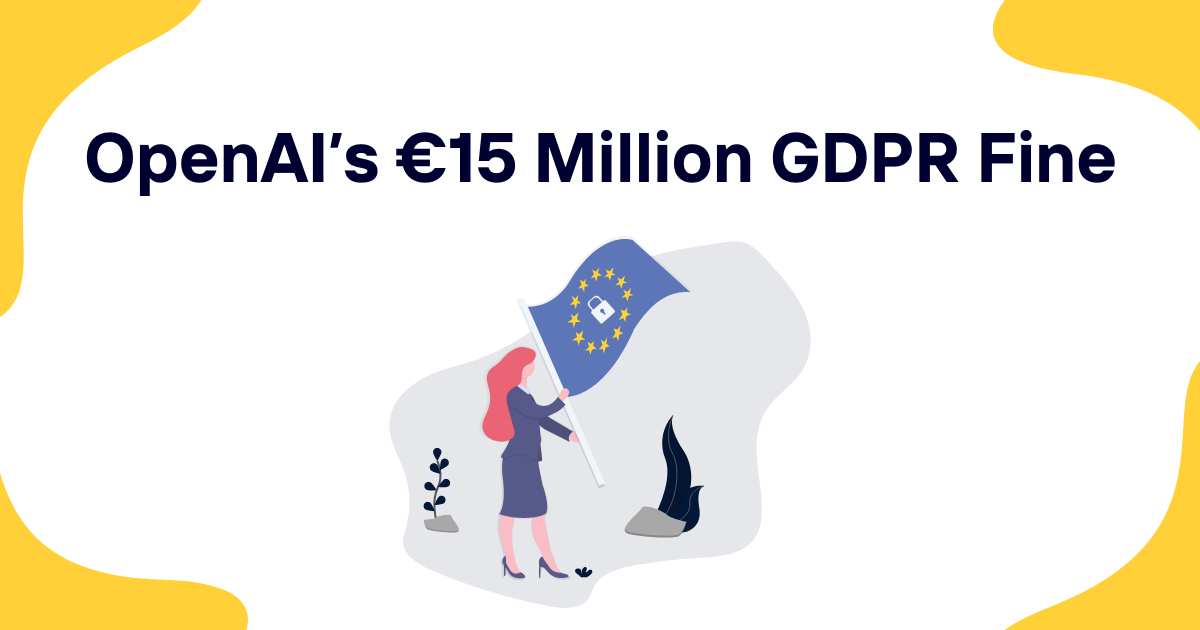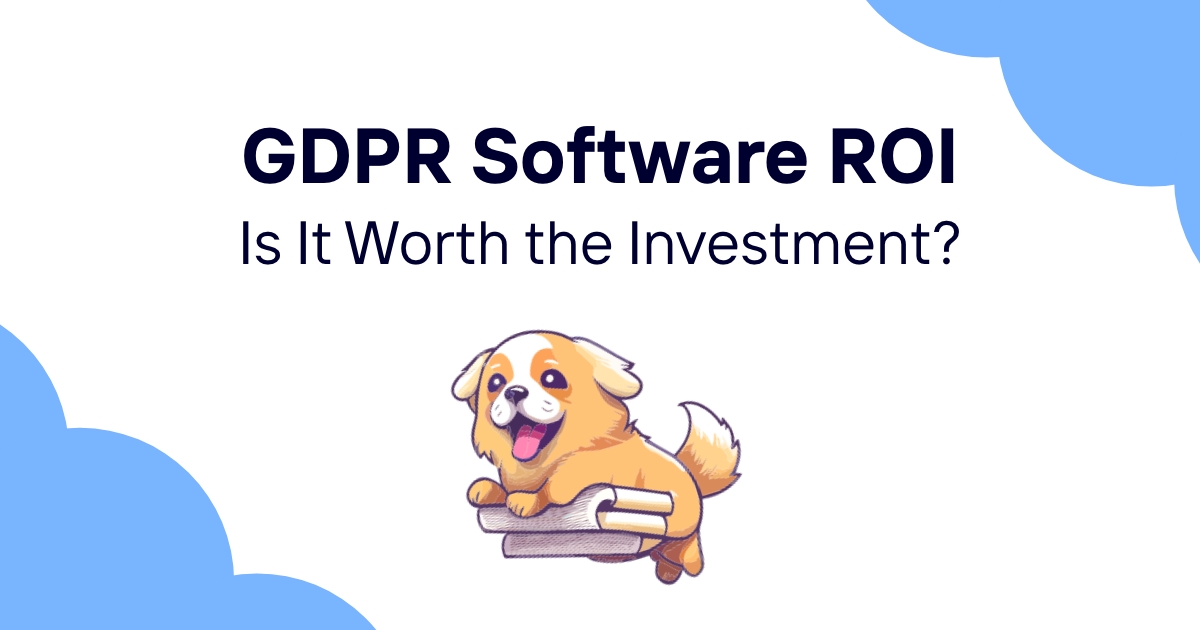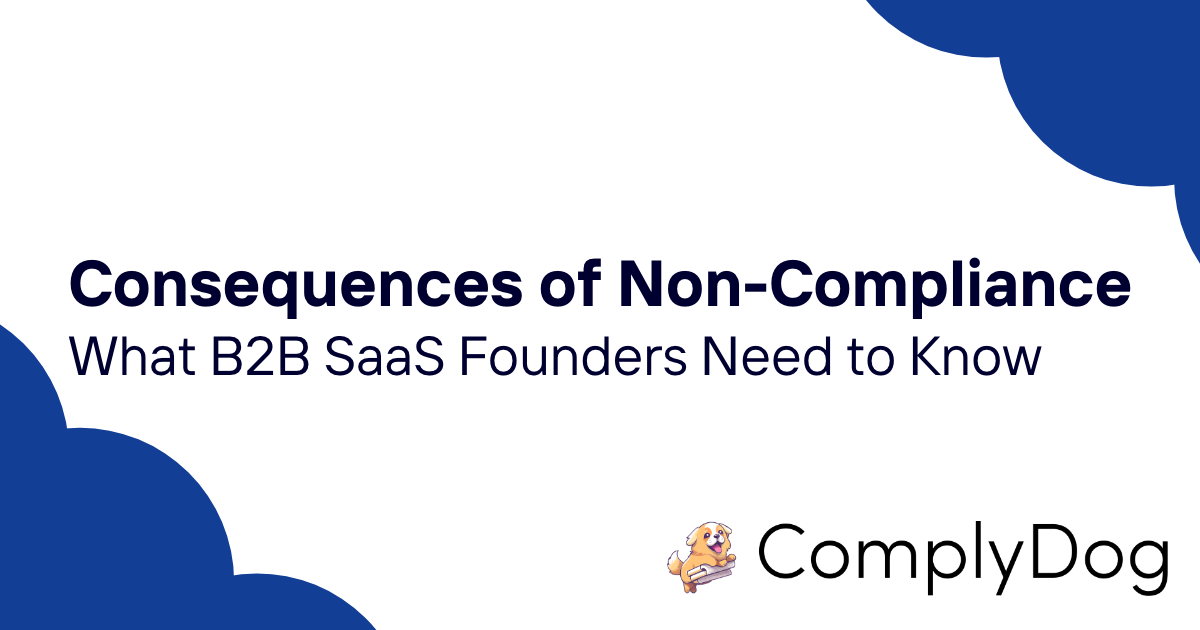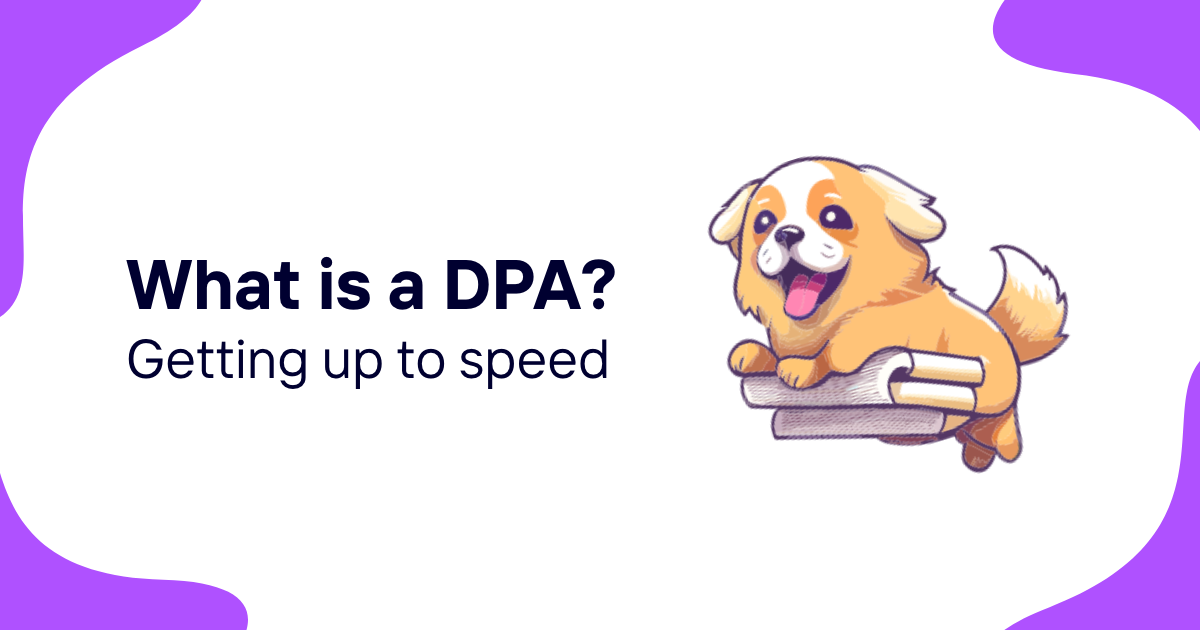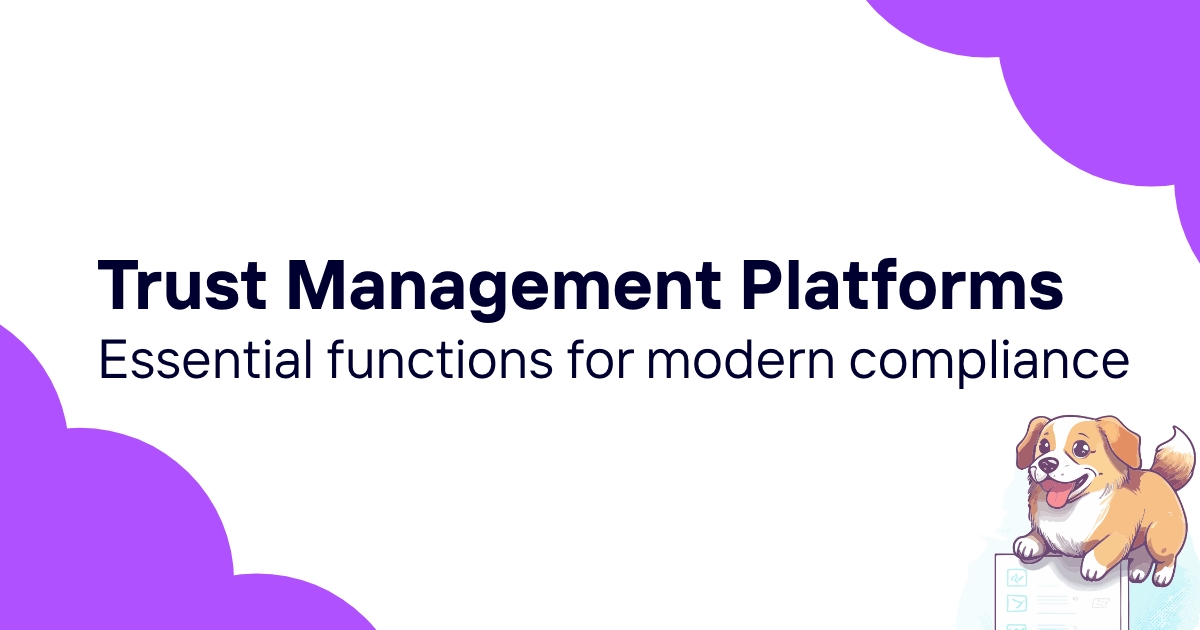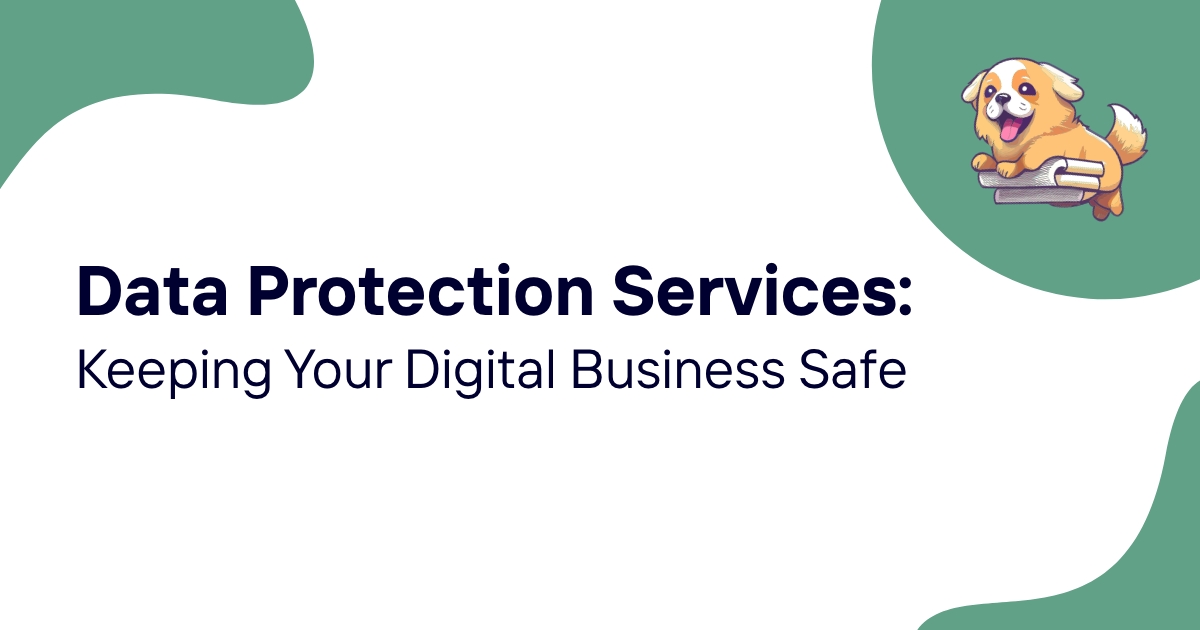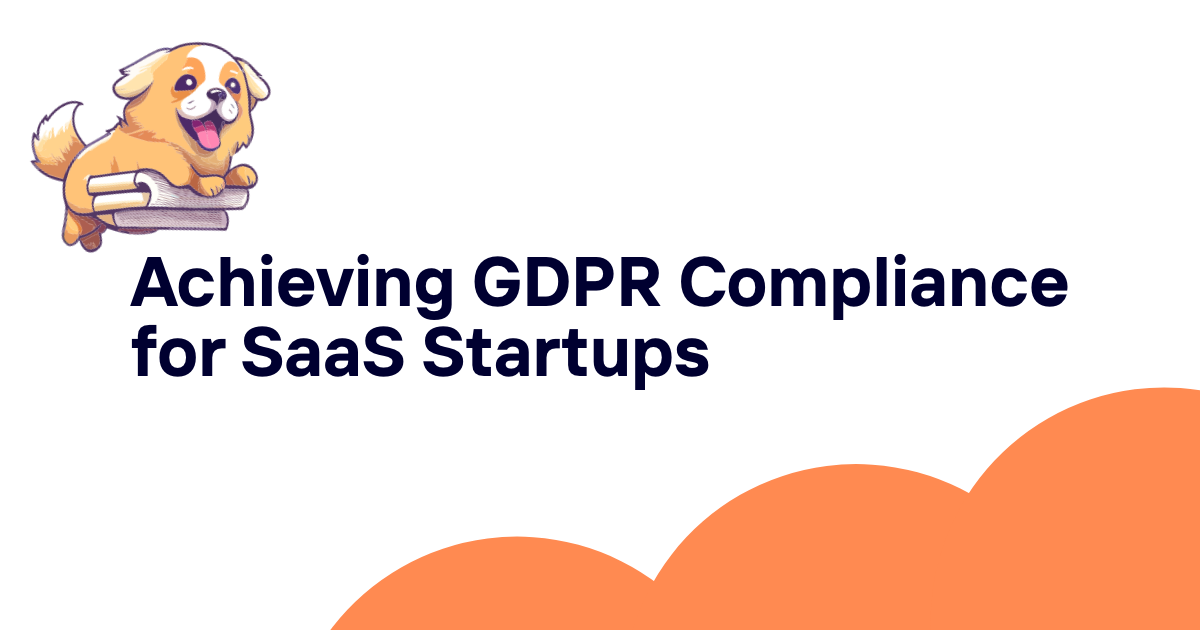The seven GDPR principles form the foundation of all data protection activities under the General Data Protection Regulation. Understanding these principles isn't just about regulatory compliance – it's about building sustainable business practices that protect individual privacy while enabling responsible data use.
This comprehensive guide explains each GDPR principle in detail, providing practical implementation strategies and real-world examples. Whether you're building your first privacy program or strengthening existing practices, mastering these principles is essential for effective GDPR compliance.
The 7 GDPR Principles Overview
GDPR Article 5 establishes seven fundamental principles that govern all personal data processing activities. These principles work together to create a comprehensive framework for responsible data handling that balances individual privacy rights with legitimate business needs.
Foundation of Data Protection Law
The GDPR principles represent decades of evolution in privacy law and reflect fundamental human rights concepts:
Privacy as a Human Right: The principles recognize privacy as a fundamental human right that requires active protection rather than passive respect.
Balanced Approach: The framework balances individual privacy rights with legitimate business needs and societal benefits from data processing.
Technology Neutral: The principles apply regardless of specific technologies used, ensuring relevance as technology evolves.
Risk-Based Framework: The principles support risk-based approaches that focus protection efforts where they're most needed.
Interconnected Nature
The seven principles work together as an integrated system rather than independent requirements:
Complementary Protections: Each principle addresses different aspects of data protection while reinforcing the others for comprehensive coverage.
Cumulative Effect: Organizations must comply with all principles simultaneously, not choose between them based on convenience or cost.
Operational Integration: Effective compliance requires integrating all principles into business processes rather than treating them as separate compliance checks.
Continuous Application: The principles apply throughout the entire data lifecycle from collection through deletion.
Legal and Business Impact
The principles create both legal obligations and business opportunities:
Regulatory Foundation: All specific GDPR requirements derive from these fundamental principles, making understanding essential for compliance.
Enforcement Basis: Regulators evaluate compliance based on adherence to these principles, not just technical rule-following.
Competitive Advantage: Organizations that genuinely embrace these principles often gain competitive advantages through enhanced customer trust.
Operational Excellence: The principles guide toward more efficient and sustainable data management practices.
Implementation Challenges
While conceptually straightforward, implementing the principles creates practical challenges:
Resource Requirements: Proper implementation requires investment in systems, processes, and staff training.
Cultural Change: Organizations often need significant cultural shifts to embrace privacy-by-design thinking.
Technical Complexity: Modern data environments require sophisticated technical solutions to implement principles effectively.
Ongoing Commitment: The principles require continuous attention rather than one-time compliance projects.
Principle 1: Lawfulness, Fairness, and Transparency
The first GDPR principle establishes fundamental requirements for how organizations approach personal data processing, emphasizing legal compliance, ethical treatment, and clear communication.
Lawfulness Requirement
Personal data processing must have valid legal grounds under GDPR Article 6:
Legal Basis Selection: Organizations must identify specific legal bases for each processing activity before beginning data collection or use.
Consent Management: When relying on consent, organizations must obtain freely given, specific, informed, and unambiguous agreement from individuals.
Contract Performance: Processing necessary for contract execution or pre-contractual steps provides legal basis for many business activities.
Legal Obligations: Some processing is required by law, providing automatic legal basis but requiring careful documentation.
Vital Interests: Processing necessary to protect someone's life or physical safety provides legal basis in emergency situations.
Legitimate Interests: Organizations can process data for legitimate business purposes when balanced against individual privacy rights through formal assessments.
Fairness in Practice
Fairness requires considering individual expectations and impacts of data processing:
Reasonable Expectations: Processing should align with what individuals would reasonably expect based on their relationship with the organization.
Balanced Outcomes: Processing decisions should balance organizational benefits against potential negative impacts on individuals.
Vulnerable Populations: Extra care is required when processing data from children, elderly individuals, or other vulnerable groups.
Power Imbalances: Organizations must consider inherent power imbalances in relationships and avoid exploiting them through data processing.
Contextual Appropriateness: Processing should be appropriate for the specific context in which data was collected or relationships were established.
Transparency Implementation
Transparency requires clear, accessible communication about data processing activities:
Plain Language: Privacy notices must use clear, understandable language appropriate for the intended audience rather than complex legal terminology.
Complete Information: Organizations must provide comprehensive information about processing purposes, legal bases, retention periods, and individual rights.
Accessible Formats: Information must be easily accessible through appropriate channels and formats for different user groups.
Layered Approaches: Complex privacy information can be presented in layers, with essential information prominently displayed and detailed information available on request.
Timely Delivery: Privacy information must be provided at the time of data collection or before processing begins.
Practical Implementation Strategies
Implementing lawfulness, fairness, and transparency requires systematic approaches:
Legal Basis Documentation: Maintain detailed records of legal bases for all processing activities with regular review and updates.
Privacy Notice Development: Create clear, comprehensive privacy notices that explain processing activities in language appropriate for your audience.
Consent Management Systems: Implement robust systems for collecting, tracking, and honoring user consent preferences.
Fairness Assessments: Regularly evaluate processing activities for fairness implications and potential negative impacts on individuals.
Transparency Audits: Periodically review privacy communications for clarity, completeness, and accessibility.
Principle 2: Purpose Limitation
Purpose limitation requires organizations to collect personal data for specified, explicit, and legitimate purposes and prohibits further processing incompatible with those original purposes.
Specified and Explicit Purposes
Organizations must clearly define and communicate why they collect personal data:
Clear Purpose Definition: Processing purposes must be specific enough that individuals understand exactly why their data is being collected and used.
Explicit Communication: Purposes must be clearly stated to individuals rather than implied or hidden in complex legal language.
Granular Specification: Broad purposes like "business operations" or "improving services" are insufficient – organizations must specify exact business functions and benefits.
Documentation Requirements: Internal documentation must record specific purposes for each type of data processing to support compliance verification.
Stakeholder Alignment: All staff involved in data processing must understand and adhere to specified purposes for their activities.
Legitimate Purposes
Processing purposes must serve legitimate business, legal, or societal interests:
Business Justification: Commercial purposes must serve genuine business needs rather than speculative or exploitative interests.
Legal Compliance: Purposes related to legal obligations provide strong justification for data processing activities.
Public Interest: Processing that serves broader public interests may qualify for legitimate purpose designation.
Individual Benefit: Purposes that directly benefit the individuals whose data is processed typically qualify as legitimate.
Proportionality Assessment: Purposes must be proportionate to the data collected and processing activities performed.
Compatible Use Evaluation
Additional processing beyond original purposes requires compatibility assessment:
Purpose Relationship: New processing purposes must have reasonable connections to original collection purposes.
Individual Expectations: Additional processing should align with what individuals would reasonably expect based on their relationship with the organization.
Data Context: The context in which data was originally collected affects what additional uses might be considered compatible.
Impact Assessment: Organizations must evaluate potential impacts of additional processing on individual privacy and rights.
Safeguard Implementation: Additional processing may require enhanced safeguards to protect individual privacy and rights.
Implementation in Business Contexts
Purpose limitation affects various business activities and requires careful consideration:
Marketing and Communications: Marketing purposes must be specifically identified and distinguished from operational processing activities.
Analytics and Research: Data analysis purposes must be clearly defined and limited to specified research questions or business objectives.
Third-Party Sharing: Sharing data with partners or vendors requires ensuring compatibility with original collection purposes.
Product Development: Using customer data for product improvement requires ensuring compatibility with original collection purposes.
Compliance Monitoring: Internal compliance activities must be identified as legitimate purposes and properly documented.
As discussed in our what is EULA guide, software companies must clearly specify data processing purposes in both privacy notices and user agreements.
Principle 3: Data Minimization
Data minimization requires organizations to limit personal data collection and processing to what is adequate, relevant, and necessary for specified purposes.
Adequate Data Collection
Organizations must collect sufficient data to achieve their stated purposes while avoiding excess:
Purpose Alignment: Data collection must directly support identified processing purposes rather than general information gathering.
Functionality Requirements: Collect only data necessary for software functionality and business operations.
Quality Standards: Ensure collected data is sufficient for intended uses and decision-making processes.
Completeness Evaluation: Assess whether collected data provides adequate information for legitimate business purposes.
Regular Review: Periodically evaluate whether current data collection remains adequate for evolving business needs.
Relevance Assessment
All collected personal data must have clear relevance to processing purposes:
Direct Relationship: Data elements must have direct connections to specific business functions or processing activities.
Business Justification: Each type of data collected should have clear business justification related to identified purposes.
Functional Necessity: Data collection should support specific functionality rather than general monitoring or surveillance.
Value Demonstration: Organizations should be able to explain how each data element contributes to achieving processing purposes.
Elimination Process: Regularly review data collection to eliminate elements that lack clear relevance to business purposes.
Necessity Evaluation
The necessity test requires demonstrating that processing purposes cannot be achieved without specific personal data:
Alternative Assessment: Evaluate whether purposes could be achieved through less invasive means or non-personal data.
Technical Solutions: Consider privacy-enhancing technologies that reduce personal data requirements while achieving business objectives.
Aggregation Opportunities: Assess whether individual-level data is necessary or whether aggregated information would suffice.
Anonymization Potential: Evaluate opportunities to use anonymized or pseudonymized data instead of identifiable personal information.
Process Optimization: Redesign business processes to minimize personal data requirements while maintaining effectiveness.
Practical Minimization Strategies
Implementing data minimization requires both technical and organizational approaches:
Form Design: Design data collection forms to request only essential information with clear explanations for each field.
System Configuration: Configure systems to collect minimal data by default rather than comprehensive information gathering.
Progressive Disclosure: Collect additional data only when necessary for specific features or services that users actively choose to use.
Data Retention: Implement automated deletion processes to remove data that is no longer necessary for original purposes.
Regular Audits: Conduct periodic reviews of data collection practices to identify and eliminate unnecessary data gathering.
Business Benefits of Minimization
Data minimization provides advantages beyond compliance:
Reduced Risk: Collecting less personal data reduces exposure to data breaches and privacy violations.
Cost Efficiency: Storing and processing less data reduces infrastructure costs and operational complexity.
Improved Performance: Systems often perform better when handling smaller datasets and fewer data elements.
Enhanced Trust: Customers appreciate organizations that collect only necessary information and respect their privacy.
Simplified Compliance: Managing fewer data elements simplifies ongoing compliance activities and reduces administrative burden.
Principle 4: Accuracy
The accuracy principle requires organizations to ensure personal data is accurate and, where necessary, kept up to date, with reasonable steps taken to erase or rectify inaccurate data.
Accuracy Standards and Requirements
Organizations must maintain appropriate accuracy levels for their data processing contexts:
Contextual Accuracy: Accuracy requirements vary based on how data is used and the potential impact of inaccuracies on individuals.
Current Information: Data used for decision-making about individuals must reflect current circumstances when currency affects the decision quality.
Source Verification: Implement processes to verify data accuracy at collection points through appropriate validation mechanisms.
Quality Control: Establish systematic approaches for monitoring and maintaining data quality throughout the data lifecycle.
Error Detection: Implement systems that can identify potential data quality issues and flag them for review and correction.
Keeping Data Up to Date
Dynamic accuracy requirements apply when data currency affects processing outcomes:
Update Mechanisms: Provide easy ways for individuals to update their personal information when circumstances change.
Automated Refreshing: Implement systems that automatically update data from authoritative sources when appropriate and legally permissible.
Regular Validation: Periodically verify data accuracy through systematic review processes or automated validation checks.
Change Detection: Monitor for indicators that data may have become outdated or inaccurate over time.
Proactive Communication: Encourage individuals to inform organizations about changes that affect their personal data accuracy.
Rectification Obligations
Organizations must provide mechanisms for correcting inaccurate personal data:
Individual Rights: Support individuals' rights to request correction of inaccurate or incomplete personal data.
Correction Processes: Establish efficient processes for investigating accuracy claims and implementing corrections when appropriate.
Verification Procedures: Implement reasonable procedures for verifying correction requests while avoiding excessive barriers.
Systematic Updates: When corrections are made, update all systems and datasets that contain the affected information.
Third-Party Notification: Notify relevant third parties when corrections affect data that has been shared with them.
Quality Assurance Systems
Systematic approaches help maintain data accuracy throughout organizational systems:
Data Validation: Implement validation rules and checks at data entry points to prevent obviously incorrect information from entering systems.
Quality Monitoring: Regularly assess data quality through statistical sampling, automated checking, and user feedback analysis.
Source Management: Maintain awareness of data source reliability and implement appropriate quality controls based on source characteristics.
Error Reporting: Provide easy mechanisms for staff and users to report suspected data quality issues.
Continuous Improvement: Use data quality metrics and incident analysis to continuously improve accuracy maintenance processes.
Technology Solutions for Accuracy
Various technical approaches support data accuracy maintenance:
Automated Validation: Use software tools to automatically validate data against known patterns, ranges, and consistency rules.
Data Integration: Implement systems that consolidate data from multiple sources to provide more complete and accurate information.
Real-Time Updating: Use APIs and automated feeds to keep data current with authoritative sources when appropriate.
Deduplication Systems: Implement tools that identify and resolve duplicate records that can cause accuracy problems.
Audit Logging: Maintain comprehensive logs of data changes to support accuracy verification and correction processes.
Principle 5: Storage Limitation
Storage limitation requires organizations to keep personal data only as long as necessary for the purposes for which it was collected and processed.
Retention Period Determination
Organizations must establish appropriate retention periods based on legitimate business and legal requirements:
Purpose-Based Retention: Retention periods must align with the original purposes for data collection and processing.
Legal Requirements: Some data must be retained for specific periods to comply with legal obligations in areas like taxation, employment, or financial regulation.
Business Necessity: Retention should continue only as long as data serves genuine business purposes that justify continued storage.
Risk Assessment: Consider privacy risks associated with continued retention against business benefits of data preservation.
Regular Review: Periodically reassess retention periods to ensure they remain appropriate for current business needs and legal requirements.
Automated Deletion Systems
Technical implementation of storage limitation requires systematic approaches:
Deletion Scheduling: Implement automated systems that delete data according to predetermined schedules based on data type and collection date.
Trigger-Based Deletion: Configure systems to automatically delete data when specific conditions are met, such as account closure or contract termination.
Exception Management: Develop processes for managing exceptions to automatic deletion when legal or business circumstances require extended retention.
Secure Deletion: Ensure deletion processes completely remove data from all systems including backups, caches, and distributed storage.
Deletion Verification: Implement processes to verify that deletion has been completed successfully across all relevant systems.
Legal and Regulatory Considerations
Retention requirements often involve balancing privacy principles with other legal obligations:
Regulatory Retention: Various regulations require retaining specific types of data for defined periods, creating minimum retention requirements.
Litigation Holds: Legal proceedings may require preserving data beyond normal retention periods until litigation is resolved.
Audit Requirements: Regulatory audits may require retaining data to demonstrate compliance with various legal obligations.
Cross-Border Considerations: Different jurisdictions may have conflicting retention requirements that require careful legal analysis.
Sector-Specific Rules: Industries like healthcare, finance, and education often have specific retention requirements that affect storage limitation implementation.
Practical Implementation Strategies
Effective storage limitation requires comprehensive organizational approaches:
Retention Schedules: Develop detailed retention schedules that specify retention periods for different types of data based on legal and business requirements.
Policy Documentation: Create clear policies that explain retention decisions and provide guidance for staff handling personal data.
System Configuration: Configure systems to automatically enforce retention policies without requiring manual intervention.
Staff Training: Train all staff who handle personal data about retention requirements and proper deletion procedures.
Regular Audits: Conduct periodic audits to verify that retention policies are being followed and deletion processes are working correctly.
Archiving and Long-Term Storage
Some organizations need to balance storage limitation with legitimate long-term retention needs:
Archiving Strategies: Develop approaches for archiving data that balance storage limitation with legitimate historical preservation needs.
Access Restrictions: Implement enhanced access controls for archived data to minimize privacy risks while preserving necessary information.
Anonymization Options: Consider anonymizing data for long-term retention when individual identification is not necessary for legitimate purposes.
Periodic Review: Regularly review archived data to determine whether continued retention remains justified for legitimate purposes.
Secure Storage: Ensure archived data receives appropriate security protection throughout its extended retention period.
Principle 6: Integrity and Confidentiality
The integrity and confidentiality principle requires implementing appropriate technical and organizational measures to protect personal data against unauthorized or unlawful processing, accidental loss, destruction, or damage.
Technical Security Measures
Organizations must implement robust technical controls to protect personal data:
Encryption Implementation: Use strong encryption for personal data both in transit and at rest to protect against unauthorized access.
Access Controls: Implement role-based access control systems that limit personal data access to authorized personnel with legitimate business needs.
Network Security: Deploy comprehensive network security measures including firewalls, intrusion detection, and secure communication protocols.
System Hardening: Configure systems securely with appropriate security settings, regular updates, and vulnerability management.
Backup Security: Ensure backup systems maintain the same security standards as production environments and include secure deletion capabilities.
Organizational Security Measures
Comprehensive data protection requires organizational controls beyond technical measures:
Security Policies: Develop comprehensive security policies that address personal data handling, access controls, and incident response procedures.
Staff Training: Provide regular security awareness training for all staff who handle personal data or have access to relevant systems.
Vendor Management: Implement security requirements for vendors and third parties who process personal data on your behalf.
Physical Security: Protect facilities, equipment, and storage media containing personal data from unauthorized physical access.
Security Monitoring: Implement ongoing security monitoring and incident detection capabilities to identify potential threats quickly.
Data Integrity Protection
Maintaining data integrity requires protecting against both intentional and accidental data corruption:
Change Controls: Implement systematic controls over data modifications to prevent unauthorized changes and maintain audit trails.
Backup and Recovery: Develop comprehensive backup and disaster recovery procedures that preserve data integrity during system failures.
Quality Assurance: Implement processes to detect and correct data corruption or quality degradation over time.
Version Control: Maintain appropriate version control for data changes to support integrity verification and rollback capabilities.
Validation Systems: Use automated validation to detect data integrity problems and prevent propagation of corrupted information.
Confidentiality Safeguards
Protecting data confidentiality requires comprehensive approaches to access control and information sharing:
Need-to-Know Access: Limit data access to personnel who specifically need information for legitimate business purposes.
Data Classification: Classify personal data based on sensitivity levels and implement appropriate protection measures for each classification.
Secure Communication: Use encrypted communication channels for transmitting personal data between systems and organizations.
Information Sharing Controls: Implement controls over data sharing with third parties including contractual protections and technical safeguards.
Confidentiality Training: Train staff about confidentiality requirements and appropriate handling of sensitive personal information.
Incident Response and Breach Management
Effective security requires preparation for security incidents and potential data breaches:
Incident Detection: Implement monitoring systems that can quickly identify potential security incidents affecting personal data.
Response Procedures: Develop detailed incident response procedures that include containment, investigation, and recovery activities.
Breach Notification: Establish processes for evaluating security incidents and determining when breach notification requirements apply.
Recovery Planning: Develop comprehensive recovery plans that restore normal operations while preserving evidence and preventing further damage.
Lessons Learned: Implement processes for learning from security incidents and improving protection measures based on experience.
As outlined in our GDPR software solutions guide, comprehensive security often requires specialized tools and platforms that can provide appropriate technical and organizational measures.
Principle 7: Accountability
The accountability principle requires organizations to demonstrate compliance with all other GDPR principles through comprehensive documentation, governance, and proactive compliance measures.
Demonstrable Compliance
Organizations must be able to prove they comply with GDPR requirements rather than simply claiming compliance:
Documentation Requirements: Maintain comprehensive records of all data processing activities, legal bases, and compliance measures.
Policy Implementation: Develop and implement policies that address all GDPR requirements and demonstrate organizational commitment to compliance.
Audit Trails: Create detailed audit trails that show how personal data is processed and how compliance decisions are made.
Regular Assessments: Conduct systematic assessments of compliance status and identify areas requiring improvement or additional attention.
Evidence Collection: Gather and organize evidence that demonstrates compliance with each GDPR principle and requirement.
Governance and Oversight
Effective accountability requires strong governance structures and oversight mechanisms:
Leadership Commitment: Ensure senior leadership demonstrates commitment to privacy protection through resource allocation and policy support.
Responsibility Assignment: Clearly assign privacy responsibilities throughout the organization with appropriate authority and accountability.
Performance Monitoring: Implement metrics and monitoring systems that track compliance performance and identify emerging issues.
Regular Reporting: Establish regular reporting on privacy compliance status to senior leadership and relevant stakeholders.
Continuous Improvement: Use compliance monitoring and assessment results to continuously improve privacy practices and protection measures.
Privacy by Design Implementation
Accountability requires building privacy protection into systems and processes from the beginning:
System Design: Integrate privacy considerations into system design and development processes rather than adding them as afterthoughts.
Process Development: Build privacy protections into business processes and workflow design from initial conception.
Default Settings: Configure systems and processes to use privacy-protective settings by default rather than requiring user configuration.
Impact Assessment: Conduct privacy impact assessments for new projects and initiatives that affect personal data processing.
Vendor Selection: Include privacy requirements in vendor selection criteria and contract negotiation processes.
Record Keeping and Documentation
Comprehensive documentation forms the foundation of accountability compliance:
Processing Records: Maintain detailed records of all personal data processing activities as required by GDPR Article 30.
Legal Basis Documentation: Document the legal basis for each type of processing and maintain evidence supporting legal basis decisions.
Consent Records: When relying on consent, maintain detailed records of when, how, and for what purposes consent was obtained.
Policy Documentation: Develop and maintain comprehensive privacy policies and procedures that address all GDPR requirements.
Training Records: Document privacy training provided to staff and maintain evidence of organizational commitment to privacy education.
Proactive Compliance Management
Accountability requires proactive approaches to compliance rather than reactive responses to problems:
Risk Assessment: Regularly assess privacy risks associated with data processing activities and implement appropriate mitigation measures.
Compliance Monitoring: Implement ongoing monitoring systems that identify potential compliance issues before they become serious problems.
Regular Audits: Conduct systematic privacy audits to verify compliance and identify improvement opportunities.
Stakeholder Engagement: Engage with relevant stakeholders including data protection authorities, customers, and privacy advocates.
Industry Participation: Participate in industry initiatives and best practice development to stay current with evolving privacy expectations.
Implementing GDPR Principles in Practice
Successfully implementing GDPR principles requires systematic approaches that integrate privacy protection into all aspects of organizational operations.
Organizational Integration
Effective implementation requires embedding principles throughout organizational culture and operations:
Cultural Change: Foster organizational cultures that value privacy protection and view it as essential to business success rather than a compliance burden.
Process Integration: Build privacy considerations into all business processes from strategy development through operational execution.
Performance Metrics: Include privacy performance metrics in organizational scoreboards and individual performance evaluations.
Resource Allocation: Allocate appropriate resources for privacy implementation including budget, staff time, and technology investments.
Leadership Modeling: Ensure senior leadership models appropriate privacy behaviors and demonstrates organizational commitment.
Technology Implementation
Modern data environments require sophisticated technical approaches to implement GDPR principles effectively:
Privacy-Enhancing Technologies: Implement technologies that support privacy protection including encryption, anonymization, and privacy-preserving analytics.
Automated Compliance: Use automation to implement compliance measures that would be impractical to manage manually at scale.
Integration Platforms: Deploy platforms that integrate privacy compliance with existing business systems and workflows.
Monitoring Systems: Implement continuous monitoring that tracks compliance status and identifies potential issues in real-time.
User Interfaces: Design user interfaces that make privacy-protective choices easy and privacy-invasive choices more difficult.
Continuous Improvement
GDPR compliance requires ongoing attention and continuous improvement rather than one-time implementation:
Regular Assessment: Conduct periodic assessments of principle implementation and identify areas needing improvement.
Feedback Integration: Use feedback from individuals, regulators, and stakeholders to improve privacy practices.
Best Practice Research: Stay current with evolving best practices and incorporate relevant improvements into organizational practices.
Regulatory Monitoring: Monitor regulatory developments and enforcement actions to understand evolving compliance expectations.
Innovation Integration: Ensure new business initiatives and technological innovations include appropriate privacy considerations from the beginning.
Success Measurement
Effective principle implementation requires measuring success and demonstrating continuous improvement:
Compliance Metrics: Develop metrics that measure adherence to each principle and overall compliance program effectiveness.
Risk Indicators: Monitor key risk indicators that could signal potential compliance problems or emerging privacy risks.
Stakeholder Satisfaction: Measure stakeholder satisfaction with privacy practices including customer trust and employee confidence.
Operational Efficiency: Track how privacy implementation affects operational efficiency and identify opportunities for optimization.
Competitive Advantage: Assess how strong privacy practices contribute to competitive positioning and business success.
Building effective GDPR principle implementation requires combining legal understanding with practical business considerations and technical capabilities. The most successful approaches treat privacy principles as business enablers rather than compliance obstacles.
For organizations looking to implement comprehensive privacy programs based on GDPR principles, integrated platforms offer significant advantages over managing compliance through disconnected tools and manual processes that make demonstrating accountability difficult.
Ready to implement GDPR principles systematically throughout your organization? Use ComplyDog and get comprehensive privacy program implementation that integrates all seven GDPR principles into automated workflows, documentation systems, and ongoing compliance monitoring that demonstrates accountability and builds customer trust.
